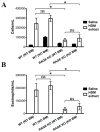Pulmonary receptor for advanced glycation end-products promotes asthma pathogenesis through IL-33 and accumulation of group 2 innate lymphoid cells
- PMID: 25930197
- PMCID: PMC4562894
- DOI: 10.1016/j.jaci.2015.03.011
Pulmonary receptor for advanced glycation end-products promotes asthma pathogenesis through IL-33 and accumulation of group 2 innate lymphoid cells
Abstract
Background: Single nucleotide polymorphisms in the human gene for the receptor for advanced glycation end-products (RAGE) are associated with an increased incidence of asthma. RAGE is highly expressed in the lung and has been reported to play a vital role in the pathogenesis of murine models of asthma/allergic airway inflammation (AAI) by promoting expression of the type 2 cytokines IL-5 and IL-13. IL-5 and IL-13 are prominently secreted by group 2 innate lymphoid cells (ILC2s), which are stimulated by the proallergic cytokine IL-33.
Objective: We sought to test the hypothesis that pulmonary RAGE is necessary for allergen-induced ILC2 accumulation in the lung.
Methods: AAI was induced in wild-type and RAGE knockout mice by using IL-33, house dust mite extract, or Alternaria alternata extract. RAGE's lung-specific role in type 2 responses was explored with bone marrow chimeras and induction of gastrointestinal type 2 immune responses.
Results: RAGE was found to drive AAI by promoting IL-33 expression in response to allergen and by coordinating the inflammatory response downstream of IL-33. Absence of RAGE impedes pulmonary accumulation of ILC2s in models of AAI. Bone marrow chimera studies suggest that pulmonary parenchymal, but not hematopoietic, RAGE has a central role in promoting AAI. In contrast to the lung, the absence of RAGE does not affect IL-33-induced ILC2 influx in the spleen, type 2 cytokine production in the peritoneum, or mucus hypersecretion in the gastrointestinal tract.
Conclusions: For the first time, this study demonstrates that a parenchymal factor, RAGE, mediates lung-specific accumulation of ILC2s.
Keywords: Asthma; IL-33; group 2 innate lymphoid cells; receptor for advanced glycation end-products.
Copyright © 2015 American Academy of Allergy, Asthma & Immunology. Published by Elsevier Inc. All rights reserved.
Conflict of interest statement
Figures







Similar articles
-
RAGE-dependent VCAM-1 expression in the lung endothelium mediates IL-33-induced allergic airway inflammation.Allergy. 2019 Jan;74(1):89-99. doi: 10.1111/all.13500. Epub 2018 Nov 22. Allergy. 2019. PMID: 29900561
-
The receptor for advanced glycation end products is a critical mediator of type 2 cytokine signaling in the lungs.J Allergy Clin Immunol. 2019 Sep;144(3):796-808.e12. doi: 10.1016/j.jaci.2019.03.019. Epub 2019 Mar 30. J Allergy Clin Immunol. 2019. PMID: 30940519
-
Activation through toll-like receptor 2 on group 2 innate lymphoid cells can induce asthmatic characteristics.Clin Exp Allergy. 2019 Dec;49(12):1624-1632. doi: 10.1111/cea.13490. Epub 2019 Sep 30. Clin Exp Allergy. 2019. PMID: 31494992
-
Group 2 innate lymphoid cells (ILC2s): The spotlight in asthma pathogenesis and lung tissue injury.Allergol Immunopathol (Madr). 2021 Mar 1;49(2):208-216. doi: 10.15586/aei.v49i2.29. eCollection 2021. Allergol Immunopathol (Madr). 2021. PMID: 33641310 Review.
-
Lung ILC2s link innate and adaptive responses in allergic inflammation.Trends Immunol. 2015 Mar;36(3):189-95. doi: 10.1016/j.it.2015.01.005. Epub 2015 Feb 19. Trends Immunol. 2015. PMID: 25704560 Review.
Cited by
-
Dynamic Interplay Between Microbiota and Mucosal Immunity in Early Shaping of Asthma and its Implication for the COVID-19 Pandemic.J Asthma Allergy. 2020 Sep 28;13:369-383. doi: 10.2147/JAA.S272705. eCollection 2020. J Asthma Allergy. 2020. PMID: 33061464 Free PMC article. Review.
-
Repeated Mouse Lung Exposures to Stachybotrys chartarum Shift Immune Response from Type 1 to Type 2.Am J Respir Cell Mol Biol. 2016 Oct;55(4):521-531. doi: 10.1165/rcmb.2015-0291OC. Am J Respir Cell Mol Biol. 2016. PMID: 27148627 Free PMC article.
-
IL-4 production by group 2 innate lymphoid cells promotes food allergy by blocking regulatory T-cell function.J Allergy Clin Immunol. 2016 Sep;138(3):801-811.e9. doi: 10.1016/j.jaci.2016.02.030. Epub 2016 Apr 18. J Allergy Clin Immunol. 2016. PMID: 27177780 Free PMC article.
-
An Alarmin Role for P2Y13 Receptor during Viral-driven Asthma Exacerbations.Am J Respir Crit Care Med. 2022 Feb 1;205(3):263-265. doi: 10.1164/rccm.202111-2571ED. Am J Respir Crit Care Med. 2022. PMID: 34936856 Free PMC article. No abstract available.
-
Alarmins and MicroRNAs, a New Axis in the Genesis of Respiratory Diseases: Possible Therapeutic Implications.Int J Mol Sci. 2023 Jan 16;24(2):1783. doi: 10.3390/ijms24021783. Int J Mol Sci. 2023. PMID: 36675299 Free PMC article. Review.
References
-
- Barlow JL, Peel S, Fox J, Panova V, Hardman CS, Camelo A, et al. IL-33 is more potent than IL-25 in provoking IL-13-producing nuocytes (type 2 innate lymphoid cells) and airway contraction. J Allergy Clin Immunol. 2013 Oct;132(4):933–41. Epub 2013/07/03. eng. - PubMed
-
- Chu DK, Llop-Guevara A, Walker TD, Flader K, Goncharova S, Boudreau JE, et al. IL-33, but not thymic stromal lymphopoietin or IL-25, is central to mite and peanut allergic sensitization. J Allergy Clin Immunol. 2013 Jan;131(1):187–200. e1–8. Epub 2012/09/26. eng. - PubMed
-
- Schmitz J, Owyang A, Oldham E, Song Y, Murphy E, McClanahan TK, et al. IL-33, an interleukin-1-like cytokine that signals via the IL-1 receptor-related protein ST2 and induces T helper type 2-associated cytokines. Immunity. 2005 Nov;23(5):479–90. Epub 2005/11/16. eng. - PubMed
Publication types
MeSH terms
Substances
Grants and funding
- 5T32HL094295-03/HL/NHLBI NIH HHS/United States
- 1T32HL094295/HL/NHLBI NIH HHS/United States
- AI048927/AI/NIAID NIH HHS/United States
- R01 HL113956/HL/NHLBI NIH HHS/United States
- 1T32HL094295-01A2/HL/NHLBI NIH HHS/United States
- R01 AI048927/AI/NIAID NIH HHS/United States
- R21 HL095495/HL/NHLBI NIH HHS/United States
- 5T32HL094295-04/HL/NHLBI NIH HHS/United States
- UL1 TR000005/TR/NCATS NIH HHS/United States
- F30 ES024045/ES/NIEHS NIH HHS/United States
- 5R21HL095495-02/HL/NHLBI NIH HHS/United States
- 5T32HL094295/HL/NHLBI NIH HHS/United States
- HL113956/HL/NHLBI NIH HHS/United States
- 1F30ES024045-01/ES/NIEHS NIH HHS/United States
- T32 HL094295/HL/NHLBI NIH HHS/United States
LinkOut - more resources
Full Text Sources
Other Literature Sources
Medical

